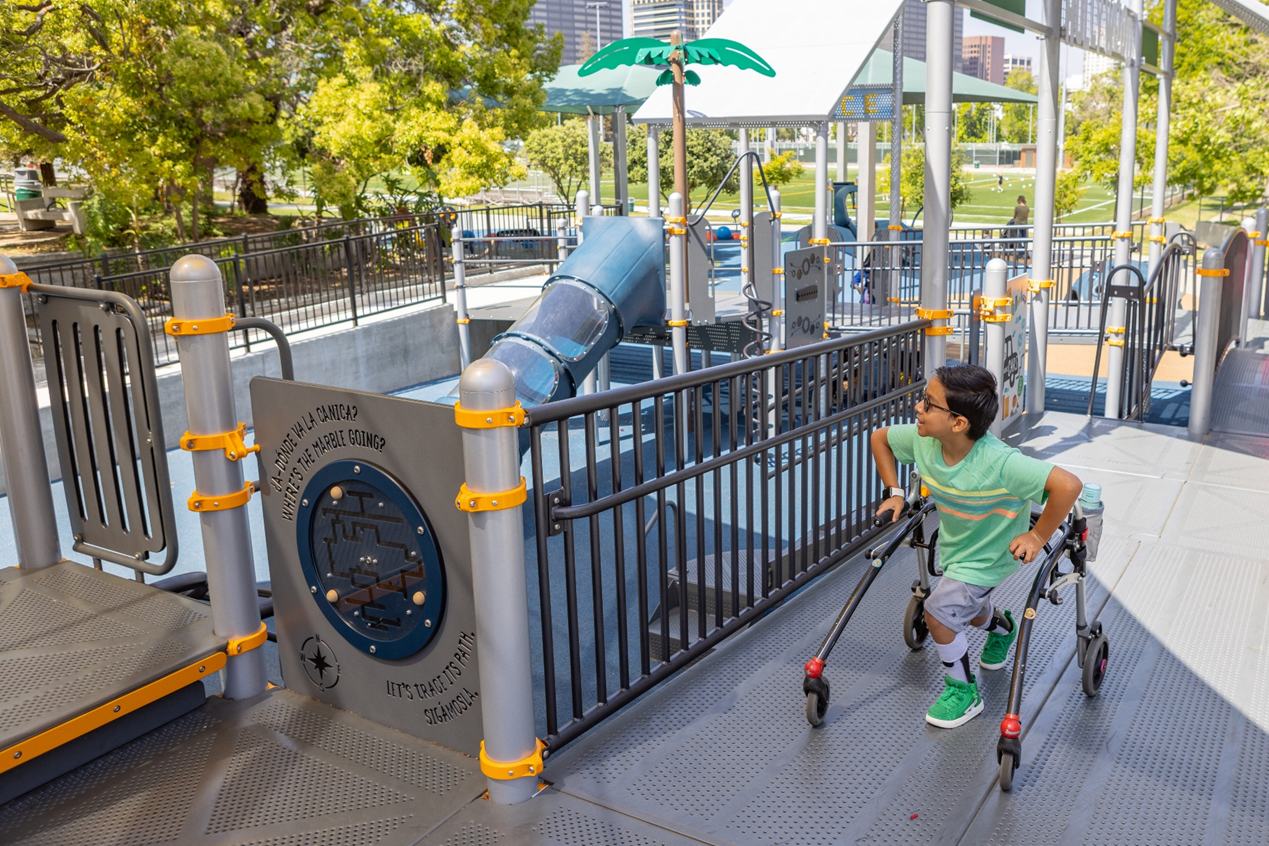Benefits of Playground Use in Therapeutic Interventions
Playgrounds aren’t just for recess, they’re powerful, evidence-informed environments where children build motor skills, language, executive function, and social-emotional regulation. When designed inclusively and used with intent, they become natural “therapy spaces” that boost engagement, generalize skills to real life, and accelerate progress for children with diverse abilities.
Why do playgrounds work so well for use by therapists?
Play is intrinsically motivating and neurologically rich. Outdoor play activates systems tied to balance, body awareness, attention, and emotional regulation; it also increases opportunities for peer interaction and spontaneous communication. Multiple studies summarized in our white paper "The Therapeutic Use of Playgrounds for Children: A Research Perspective" show gains in motor planning, postural control, self-regulation, and social participation when therapy moves outside to inclusive play spaces. Delivering care in natural contexts further supports carryover to home and school routines—one reason professional bodies and education policy encourage play in real-world settings.
Mapping equipment to therapeutic goals
Different features target different systems and outcomes, allowing OTs, PTs, SLPs, and families to provide the right inputs and gradually raise challenges.
- Swings (belt, high-back, adaptive, group): Robust vestibular input for balance, spatial orientation, arousal modulation, and calming; paired with breathing cues or rhythm games to build self-regulation and attention.
- Climbing nets, ladders, and walls: Proprioception, bilateral coordination, grip strength, core stability, and motor planning; excellent for praxis and confidence building with clear “route” goals.
- Slides: Vestibular + proprioceptive input; opportunities for sequencing (“climb—sit—push—land”) and core activation; can be used for turn-taking scripts with peers.
- Balance elements (beams, pods, wobble features): Postural control, gait training, ankle strategy, and graded balance reactions; progress from hand-held assist to independent traverses.
- Seesaws and group spinners: Co-regulation, timing, and social reciprocity; children learn to match force and rhythm with a partner or team.
- Interactive play panels (tactile, cause-and-effect, music): Fine-motor dexterity, joint attention, vocabulary, and AAC opportunities; ideal for eliciting requests, labeling actions, and short social exchanges.
- Water/sensory zones: Tactile exploration, graded tolerance, and fine-motor control with scooping, pouring, and tool use; soothing sensory input that can downshift arousal.

What makes a playground effective for occupational therapy?
Effective OT environments provide varied sensory inputs, graded challenges, and clear affordances for independence. At the site level, the strongest outcomes occur in spaces with:
- Accessible circulation and surfacing (unitary surfacing, generous ramps, barrier-free transfers) to support mobility, positioning, and safe spotting;
- A range of intensities (from quiet, single-user play to dynamic group motion) so therapists can increase or decrease arousal;
- Opportunities for praxis (multi-step routes, problem-solving panels, and loose “courses” that invite planning and sequencing);
- Social scaffolds (side-by-side stations, multi-seat swings, and cooperative equipment that naturally prompt turn-taking); and
- Built-in communication supports (simple signage, visual schedules, and AAC boards near high-value features). These characteristics let OTs address modulation, motor planning, fine/gross motor skills, ADL readiness, and participation—while keeping sessions playful and functional.
Therapist tip: Use short, high-fidelity circuits (e.g., 3–5 minutes per station) that combine vestibular, proprioceptive, and fine-motor elements, then embed a regulation break in a quiet zone before repeating at slightly higher challenge. This preserves engagement and models routines caregivers can replicate.
Designing for children with sensory processing disorders (SPD)
Children with SPD benefit from predictable organization, choice of input level, and safe retreat options. The white paper highlights design moves that reduce overload and expand participation:
- Zoned layouts that flow from low-stimulus (quiet huts, cocoon benches, ground-level panels) to moderate (slides, smaller climbers) to high-stimulus (spinners, group motion) areas.
- Calming retreats—shade, seating nooks, and small enclosures for breaks without leaving the play experience.
- Multi-sensory features delivered in non-overwhelming ways (textured paths, music panels, contrasting colors) with easy opt-in/opt-out.
- Clear sightlines and wayfinding so children can anticipate transitions; use of visuals and consistent cues to lower uncertainty.
- Inclusive equipment (adaptive swings, wheelchair-friendly spinners, transfer points) paired with smooth, unitary surfacing for confident navigation.
Together, these choices lower anxiety, support self-regulation, and increase time on task for therapy and play.
Practical session ideas (for clinicians and families)
- Regulate → Challenge → Regulate: for example, begin with gentle swinging or slow balance work, step up to a short climbing route with a labeling task (“first/then/last”), then cool down at a tactile or music panel to reinforce language from the session.
- Social scripts in motion: Use a two-seat swing or seesaw to practice greetings, requests (“my turn/your turn”), and simple negotiations while co-regulating movement.
- Motor + language pairing: Create an obstacle path that embeds action words (“step, reach, push, slide”) and descriptive language (“fast/slow, high/low”), prompting expressive and receptive targets as the child moves.
 What families and communities should look for
What families and communities should look for
If you’re evaluating a play space for therapy or daily use, scan for: unitary surfacing, ramps to social hubs, transfer points, mix of quiet and high-energy zones, group-friendly motion equipment, communication supports, and shade and seating for rest breaks and caregiver coaching. These elements correlate with higher participation, stronger social interaction, and better generalization of therapeutic gains.
How Whirlix Design can help
Whirlix partners with clinicians and municipalities to translate therapeutic goals into inclusive layouts, equipment selections, and phased budgets—so your playground functions as both a beloved community asset and an everyday therapy engine. If you’d like a quick design review, a therapy-focused equipment map, or spec language aligned to your goals, we’re happy to help.
Request access to our White Paper Here: “Therapeutic Play Spaces”
A special thank you to Dr. Cortney Baker Ed.D., M.S., CCC/SLP, CEO & Owner of Kids Care Home Health and Dr. Ariel Mansholt, OTR/L, CPSI, Occupational Therapist & Inclusive Play Specialist, Landscape Structures for their input and guidance!

